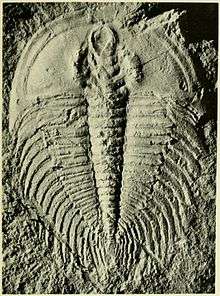Nevadella
Nevadella is an extinct genus of trilobites, fossil marine arthropods, with species of average size (about 5 centimetres or 2.0 inches long). It lived during the late Atdabanian stage, which lasted from 530 to 524 million years ago during the early part of the Cambrian Period.[3]
| Nevadella | |
|---|---|
 | |
| Nevadella eucharis, type specimen | |
| Scientific classification | |
| Kingdom: | |
| Phylum: | |
| Class: | |
| Order: | |
| Superfamily: | Nevadioidea[1] |
| Family: | "Nevadiidae" |
| Genus: | Nevadella Raw, 1936 |
| Species | |

Etymology
The name is derived from Nevadia, a related genus.
Taxonomy
Nevadia predates Nevadella and may include its direct ancestor.
Species previously assigned to Nevadella
- N. burri = Pleisionevadella burri
Description
The body of Nevadella is very flat dorso-ventrally. The general outline of its thin, lightly calcified exoskeleton is inverted drop-shaped. The front is rounded, widest at the back of the headshield (or cephalon), and tapering from there to an eventually rounded termination. The central area of the cephalon (or glabella) is distinctly tapered forward, sides slightly concave, but wedging out slightly in the frontal half and with a rounded front (like the silhuette of a slim pawn). The glabella and the frontal margin almost or entirely touch (in jargon: the preglabellar field is short or absent). Cephalic margin at least as wide as the most frontal thoracal segment. The thorax has 17 to 23 segments, gradually diminishing in size. The pleural spines are long and sickle-shaped. The tailshield (or pygidium) is very small and subquadrate in shape.[4]
Distribution
Fossils of Nevadella have been found in the late Atdabanian of the USA (California, Nevada) and Canada (Cordilleran region).
- N. eucharis is known from the Middle Member of the Poleta Formation, Esmeralda County, Nevada, USA.[5]
- N. keelensis is known from the Sekwi Formation, Northwest Territories, Canada.[6][7]
- N. mountjoyi is known from the Mural Formation, north slope of Mount Mumm, Alberta, Canada.[8]
- N. perfecta is known from the Mahto Formation, Mumm Peak on the west side of Hitka Pass, western Alberta, Canada.[9]
Ecology
Contemporary taxa that also occur in the so-called "Nevadella" Zone include Esmeraldina, Holmiella, Palmettaspis, Bradyfallotaspis, Geraldinella, Paranevadella, Nevadia, Buenellus, and Cirquella.[4]
Habitat
Nevadella species were probably marine bottom dwellers, like all Olenellina.
References
- Lieberman, B.S. (1998). "Cladistic Analysis of the Early Cambrian Olenelloid Trilobites" (PDF). Journal of Paleontology. 72 (1): 59–78. doi:10.1017/S0022336000024021.
- Lieberman, B. S. (2001). "Phylogenetic Analysis of the Olenellina Walcott, 1890 (Trilobita, Cambrian)". Journal of Paleontology. 75 (1): 96–115. doi:10.1666/0022-3360(2001)075<0096:PAOTOW>2.0.CO;2.
- Sepkoski, Jack (2002). "A compendium of fossil marine animal genera (Trilobita entry)". Bulletins of American Paleontology. 364: 560. Retrieved 2008-01-12.
- H. B. Whittington; et al. (1997). "Introduction, Order Agnostida, Order Redlichiida". Treatise on Invertebrate Paleontology. Part O, Revised. Trilobita.
- Paleobiology Database
- F. R. Abe, B. S. Lieberman, M. C. Pope, K. Dilliard (2010). "New information on olenelline trilobites from the Cambrian Sekwi Formation in northwestern Canada". Canadian Journal of Earth Sciences, 2010, 47 (12): 1445–1449.
- Life Desks, Trilobites on line
- Life Desks, Trilobites on line
- U. S. National Museum, Catalogue No. 60082.